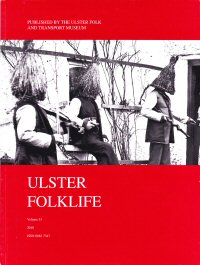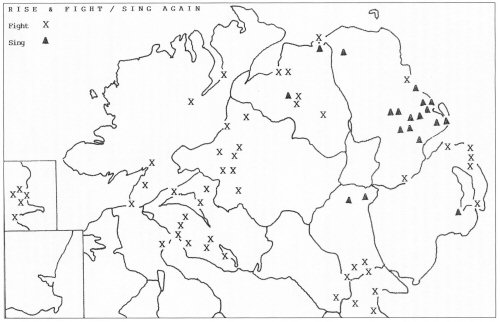 'Ulster Folklife' cover, showing 'Ulster Folklife' cover, showing
detail from a photograph by
W.A.Green of west Ulster
mummers' straw costumes.Alan Gailey is well known among folk play researchers for his two books and numerous articles on Irish folk drama. He spent his career at the Ulster Folk and Transport Museum, Cultra Manor, Co. Down, and was its Director from 1986 until 1996 when he retired. In between "annoying the trout" of various rivers and lakes, retirement has given Gailey time to revisit folk drama - or perhaps it has come back to haunt him. Either way, the result is a new extensive study of Irish folk play scripts - "Irish Mummers' Play Texts: Their Content and Development" - that is being published in "Ulster Folklife" in two parts.
The core of the study is an in-depth analysis of 99 texts collected up to the year 2000, which is about half the number of available for Ireland. This is a more than adequately representative sample, and ten times more Irish plays than are currently in my "Historical Database of Folk Play Texts".
Part One, which has just been issued, is essentially descriptive. Gailey breaks down the texts by speech and scene under 29 headings, and looks in detail at how their texts and characters vary across Ireland. These are accompanied by statistical tables and distribution maps, and compared against the benchmark of the Smith & Lyons "Christmas Rhime" chapbook - Ireland's oldest known text.
I have been fortunate to see the draft of Part Two, which will appear in 2011. I don't think I will give the game away if I say that it follows up the descriptive analysis with Gailey's arguments and conclusions, along with more maps and references.
Irish Folk plays are mostly found in the nine counties of Ulster and parts of the east coast counties of Louth, Fingal, Dublin, and Wexford. There is, however, a "hole" in the distribution for mid and eastern Co.Tyrone that as far as I know no one has yet managed to explain.

Distribution of 'rise and fight again' and 'rise and sing a song'.
While there are textual similarities between all the Irish plays, Gailey's maps show us that there are clear east - west variants, as well as localised sub-variants, such as in Co. Fermanagh. Interestingly, there is also some evidence of Scottish influence. For instance, the character Collossian at Carrigart, Co. Donegal is a close relative of the typical hero of Scottish folk plays, Galoshen, something which is supported by the rest of the script.
Alan Gailey is to be congratulated on this is a very important study, which is sure to become required reading for future researchers of Irish folk plays. His discussion in part two will be well worth the wait.
Peter Millington
Reference
Alan Gailey
(2010)
Irish Mummers' Play Texts: Their Content and Development - Part 1,
Ulster Folklife,
2010, Vol.53, pp.1-56.
(£7.00 + p&p from: Publications Department, Ulster Folk & Transport Museum, 153 Bangor Road, Cultra, Holywood, Co Down, BT18 OEU.
Email: stephen.gardiner@nmni.com)
|

